|
Dionysus
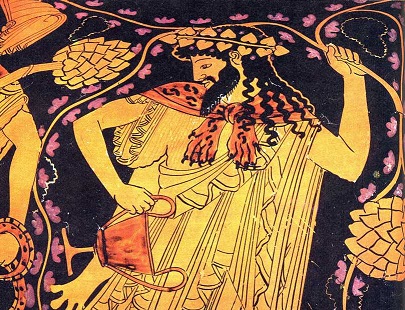
Aliases: Sabazios, Iacchus, Bacchus, Zagreus, Zalmoxis
Location: Asia Minor (Turkey), Greece, India(?)
Cities: Athens, Thebes
Estimated Date: 1200s B.C. - 400s A.D.
He is equated with Adonis and Attis
The third-century philosopher Porphyry compares Dionysus with Adonis and Attis, saying that each symbolizes the earth’s fertility. The first-century B.C. historian Dionysius of Halicarnassus compares the customs of Phrygian rites of Attis to that of Dionysus. The second-century theologian Clement of Alexandria said the reason they were connected was because they were both castrated.
For Korē was carried off by Pluto [Hades], that is, the sun going down beneath the earth at seed-time; but Dionysus begins to sprout according to the conditions of the power which, while young, is hidden beneath the earth, yet produces fine fruits, and is an ally of the power in the blossom symbolized by Attis, and of the cutting of the ripened corn symbolized by Adonis.
For those two identical fratricides, having abstracted the box in which the phallus of Bacchus was deposited, took it to Etruria— dealers in honourable wares truly. They lived there as exiles, employing themselves in communicating the precious teaching of their superstition, and presenting phallic symbols and the box for the Tyrrhenians to worship. And some will have it, not improbably, that for this reason Dionysus was called Attis, because he was mutilated. And what is surprising at the Tyrrhenians, who were barbarians, being thus initiated into these foul indignities, when among the Athenians, and in the whole of Greece— I blush to say it— the shameful legend about Demeter holds its ground? For Demeter, wandering in quest of her daughter Core, broke down with fatigue near Eleusis, a place in Attica, and sat down on a well overwhelmed with grief...
He carries a shepherd's crook-staff
The shepherd's staff, featuring the crook at the end, was a sacred symbol of Bacchus and was featured in his festivals.
His wife is associated with Venus
Dionysus’ wife Ariadne has been identified as a Minoan goddess equivalent to Aphrodite, or Venus.
He is associated with trees
Dionysus is called “god in a tree” or the “tree god”.
He is worshipped using a sacramental tree pole
A marble sarcophagus dated between 100s and 200s A.D. portrays a festival where, like Inanna and Attis, Dionysus is being lifted up as a tree pole with a head and body but no feet. A vase dated to the 400s B.C. shows women drinking wine and dancing in front of a Dionysus pole the spring festival.
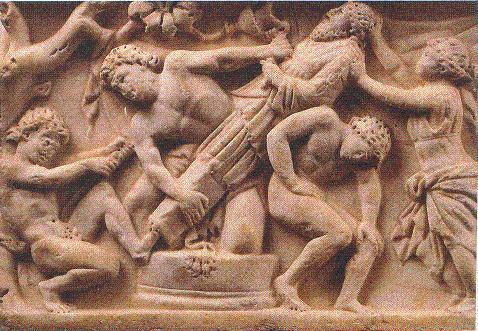
Marble sarcophagus of Dionysus pole dated 100s - 200s A.D.
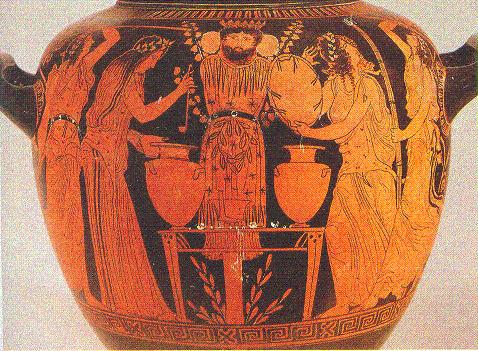
Vase displaying Dionysus pole dated to 400s B.C. (420-410 B.C.)
His festival commemorates his disappearance into the netherworld similar to that of Persephone
Indeed, there is no tradition among the Romans either of Caelus being castrated by his own sons or of Saturn destroying his own offspring to secure himself from their attempts or of Jupiter dethroning Saturn and confining his own father in the dungeon of Tartarus, or, indeed, of wars, wounds, or bonds of the gods, or of their servitude among men. And no festival is observed among them as a day of mourning or by the wearing of black garments and the beating of breasts and the lamentations of women because of the disappearance of deities, such as the Greeks perform in commemorating the rape of Persephonê and the adventures of Dionysus and all the other things of like nature. And one will see among them, even though their manners are now corrupted, no ecstatic transports, no Corybantic frenzies, no begging under the colour of religion, no bacchanals or secret mysteries, no all-night vigils of men and women together in the temples, nor any other mummery of this kind; but alike in all their words and actions with respect to the gods a reverence is shown such as is seen among neither Greeks nor barbarians. And, — the thing which I myself have marvelled at most, — notwithstanding the influx into Rome of innumerable nations which are under every necessity of worshipping their ancestral gods according to the customs of their respective countries, yet the city has never officially adopted any of those foreign practices, as has been the experience of many cities in the past; but, even though she has, in pursuance of oracles, introduced certain rites from abroad, she celebrates them in accordance with her own traditions, after banishing all fabulous clap-trap. The rites of the Idaean goddess are a case in point; for the praetors perform sacrifices and celebrated games in her honour every year according to the Roman customs, but the priest and priestess of the goddess are Phrygians, and it is they who carry her image in procession through the city, begging alms in her name according to their custom, and wearing figures upon their breasts and striking their timbrels while their followers play tunes upon their flutes in honour of the Mother of the Gods. But by a law and decree of the senate no native Roman walks in procession through the city arrayed in a parti-coloured robe, begging alms or escorted by flute-players, or worships the god with the Phrygian ceremonies. So cautious are they about admitting any foreign religious customs and so great is their aversion to all pompous display that is wanting in decorum.
He has a sacramental ritual of bread and wine consumed before the tree pole
A vase dated to the 500s B.C. shows a dead, faceless Dionysus on the pole as women take bread and wine from his altar. Another vase, dated to 450 B.C., portrays the bread and wine sacrament with Dionysus’ face intact and eyes open.
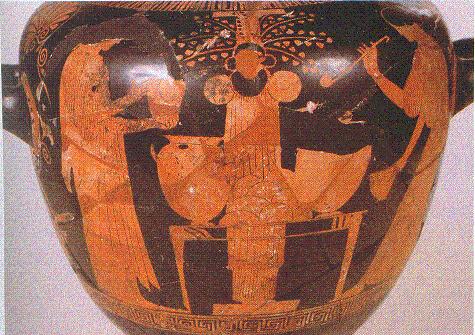

Vases displaying bread and wine consumed before Dionysus pole dated 500s - 400s B.C.
He is “born again”
He is known as the “Twice born” because he was born from Zeus’ thigh, symbolically representing being spiritually reborn from God, similar to the concept from the Gospel of John that one had to be “born again” (that is, spiritually reborn from God) in order to be saved.
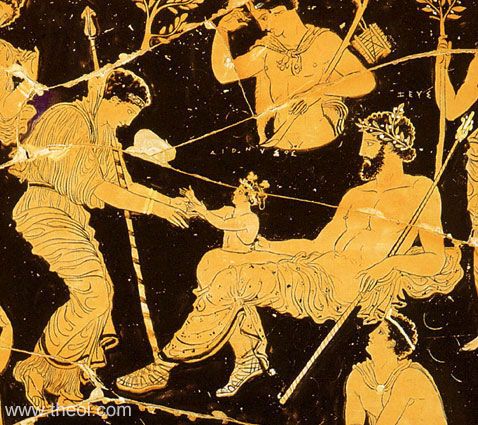
Dionysus being born from the thigh of Zeus
He is associated at birth with the crucifix
A marble sarcophagus of the “Triumph of Dionysus” from the 200s A.D. shows an old prophet holding up a crucifix at the birth of Dionysus as an omen of his pending fate, as interpreted by C. Kerényi.

Marble sarcophagus of Dionysus dated to 190s A.D.
He is depicted as a baby with a halo over his head identical to Christian art
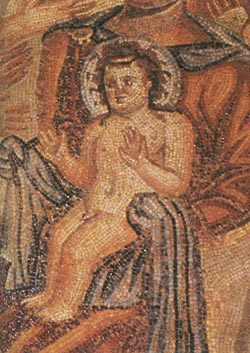
Mosaic from “The House of Dionysus” in Paphos, Cyprus, dated to 300s A.D.
He creates food and drink of immortality
Dionysus rescues the nymph Ambrosia from an evil king by changing her into a grape vine. Similar to Enki’s “plant of life” and “water of life”, the ambrosia food and drink gives the gods their immortality. Thus, it symbolically links Dionysus’ wine with immortality. Ambrosia is also the name of the autumn festival of Dionysus which the centaurs were said to have celebrated.
The books of Luke and Acts use language and a miracle from a play about him
The fifth-century B.C. Greek tragedy The Bacchae by Euripidies uses the term “kick against the goads,” or “kick against his spurs” (line 971) a common phrase used to mean going up against the divine order, which also what Paul hears on the road to Damascus in Acts 26:14. The Bacchae also uses the common motif of chains falling off and locked doors opening by themselves (line 557), just as Peter has his own shackles fall off and the locked door open for him, as well as locks falling off of Paul and Silas in Acts 12:7 and 16:25. Dionysus tells his persecutor Pentheus “You know not what you are doing, nor what you are saying, nor who you are,” (line 633), similar to Jesus in Luke saying about his persecutors, “Father, forgive them, for they know not what they are doing.”
His enemies are hung on a tree or crucified
In Euripidies’ The Bacchae, Dionysus’ enemy Pentheus is hung up at the top of a tree by Dionysus (line 1333) before his followers uproot the tree and then rip Pentheus apart. The first century B.C. Sicilian historian Diodorus also says that his other enemy kin, Lycurgus of Thrace, was crucified by Dionysus. These can be interpreted as ironic reversals of Dionysus being hung on a tree, just as Judas Iscariot commits suicide by hanging himself on a tree or how Simon the Cyrenian (a symbol for Simon bar Kokhba) took Jesus’ place on the cross in the apocaryphal Gnostic text, Second Treatise of the Great Seth.
He is accused of copying Jesus before Jesus existed
While Ehrman and other critics of mythicism have tried to argue that the death and resurrection motifs of the Dionysus mystery religion were copied from Christianity, the second century apologist Justin the Martyr knew the Dionysus mysteries preceded his own “philosophy”, so he instead argued that demons had read the prophecy of a ruler from Genesis using the wine/blood motif and so invented the myth of Dionysus long before Jesus existed so that people would notice the similarities and believe Jesus was just a myth. Incidentally, the first three gospels say that the Pharisees use the same logic as Justin when they accuse Jesus was using the power of Ba'al to exorcize the demons of Ba'al, implying the “prince of demons” was trying to trick them by making Jesus look like the good guy, to which Jesus replies, "How can Satan drive out Satan? A house divided against itself cannot stand."
But those who hand down the myths which the poets have made, adduce no proof to the youths who learn them; and we proceed to demonstrate that they have been uttered by the influence of the wicked demons, to deceive and lead astray the human race. For having heard it proclaimed through the prophets that the Christ was to come, and that the ungodly among men were to be punished by fire, they put forward many to be called sons of Jupiter [Zeus], under the impression that they would be able to produce in men the idea that the things which were said with regard to Christ were mere marvelous tales, like the things which were said by the poets. And these things were said both among the Greeks and among all nations where they [the demons] heard the prophets foretelling that Christ would specially be believed in; but that in hearing what was said by the prophets they did not accurately understand it, but imitated what was said of our Christ, like men who are in error, we will make plain. The prophet Moses, then, was, as we have already said, older than all writers; and by him, as we have also said before, it was thus predicted:
“There shall not fail a prince from Judah, nor a lawgiver from between his feet, until He come for whom it is reserved; and He shall be the desire of the Gentiles, binding His foal to the vine, washing His robe in the blood of the grape.” [Genesis 49:10]
The devils, accordingly, when they heard these prophetic words, said that Bacchus was the son of Jupiter, and gave out that he was the discoverer of the vine, and they number wine [or ass] among his mysteries; and they taught that, having been torn in pieces, he ascended into heaven.
The Jerusalem priests were said to have dressed and worshipped like his priests
The second century Roman senator Tacitus writes that Jewish priests used to dress and play like followers of Dionysus and that a Dionysian artifact was found in the Jerusalem Temple.
However, their priests used to perform their chants to the flute and drums, crowned with ivy, and a golden vine was discovered in the Temple; and this has led some to imagine that the god thus worshipped was Prince Liber, the conqueror of the East. But the two cults are diametrically opposed. Liber founded a festive and happy cult: the Jewish belief is paradoxical and degraded.
He carries an ivy wand topped with a pine cone identical to one displayed at the Jerusalem Temple
The first century Greek historian and priest of Apollo, Plutarch, links Yahweh to Bacchus by the pine cone wand (thyrsus) and tamborines (timbrels) displayed on the Jewish Temple. Tammuz is likewise displayed carrying a thyrsus.
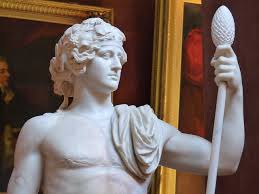
Dionysus with a Thyrsus
When all the company requested and earnestly begged it of him; first of all (says he), the time and manner of the greatest and most holy solemnity of the Jews is exactly agreeable to the holy rites of Bacchus; for that which they call the Fast they celebrate in the midst of the vintage, furnishing their tables with all sorts of fruits, while they sit under tabernacles made of vines and ivy; and the day which immediately goes before this they call the day of Tabernacles. Within a few days after they celebrate another feast, not darkly but openly, dedicated to Bacchus, for they have a feast amongst them called Kradephoria, from carrying palm-trees, and Thyrsophoria, when they enter into the temple carrying thyrsi. What they do within I know not; but it is very probable that they perform the rites of Bacchus. First they have little trumpets, such as the Grecians used to have at their Bacchanalia to call upon their Gods withal. Others go before them playing upon harps, which they call Levites, whether so named from Lusius or Evius,—either word agrees with Bacchus. And I suppose that their Sabbaths have some relation to Bacchus; for even at this day many call the Bacchi by the name of Sabbi, and they make use of that word at the celebration of Bacchus's orgies. And this may be made appear out of Demosthenes and Menander. Nor would it be absurd, were any one to say that the name Sabbath was imposed upon this feast from the agitation and excitement (σόβησις) which the priests of Bacchus indulged in. The Jews themselves testify no less; for when they keep the Sabbath, they invite one another to drink till they are drunk; or if they chance to be hindered by some more weighty business, it is the fashion at least to taste the wine. Some perhaps may surmise that these are mere conjectures. But there are other arguments which will clearly evince the truth of what I assert. The first may be drawn from their High-priest, who on holidays enters their temple with his mitre on, arrayed in a skin of a hind embroidered with gold, wearing buskins, and a coat hanging down to his ankles; besides, he has a great many little bells hanging at his garment which make a noise as he walks the streets. So in the nightly ceremonies of Bacchus (as the fashion is amongst us), they make use of musical instruments, and call the God's nursesχαλκοδρυσται. High up on the wall of their temple is a representation of the thyrsus and timbrels, which surely can belong to no other God than Bacchus. Moreover they are forbidden the use of honey in their sacrifices, because they suppose that a mixture of honey corrupts and deads the wine. And honey was used for sacrificing in former days, and with it the ancients were wont to make themselves drunk, before the vine was known. And at this day barbarous people who want wine drink metheglin, allaying the sweetness of the honey by bitter roots, much of the taste of our wine. The Greeks offered to their Gods these sober offerings or honey-offerings, as they called them, because that honey was of a nature quite contrary to wine. But this is no inconsiderable argument that Bacchus was worshipped by the Jews, in that, amongst other kinds of punishment, that was most remarkably odious by which malefactors were forbid the use of wine for so long a time as the judge was pleased to prescribe. Those thus punished… [The remainder of the Fourth Book is missing.]
He is associated with Yahweh by Jews trying to convert Romans
The first century Sicilian historian Diodorus Siculus identified Sabazios as the second Dionysus. During the first century Greek historian Strabo connected Zagreus with Sabazios (Saba-Zeus), the name of the Phrygian and Thracian mounted sky god and from which the Sabazian mysteries derive from (and, according to Aristophanes, included weeping for Adonis). According to the epitome of a lost book by the first century Latin author Valerius Maximus, both Chaldean astrologers and Jewish settlers were expelled from Rome in the 100s B.C., the latter of which for trying to convert Romans to “Jupiter Sabazius”, which is generally discredited as being a misidentification of Jove Sabazios with Jehovah Sabaoth (literally “Yahweh of Armies”, but typically translated “LORD of Hosts”).
Gnaeus Cornelius Hispalus, praetor peregrinus in the year of the consulate of Marcus Popilius Laenas and Lucius Calpurnius, ordered the astrologers by an edict to leave Rome and Italy within ten days, since by a fallacious interpretation of the stars they perturbed fickle and silly minds, thereby making profit out of their lies. The same praetor compelled the Jews, who attempted to infect the Roman custom with the cult of Jupiter Sabazius, to return to their homes.
He is associated with the serpent
Clement of Alexandria said that both the Bacchic orgies and the Sabazian mysteries involved a consecrated serpent totem, the original totem of Nammu, Enki, Dumuzi and Gizzida, as well as consecrated cakes that were used in the worship of Dumuzi's wife Inanna. In Greek folk religion, Agatho-daemon (“Noble-demon”), represented by an underworld serpent, was a good spirit presiding over vineyards that was equated with Dionysus and honored by wine libations poured at banquets.
The symbol of the Bacchic orgies is a consecrated serpent. Moreover, according to the strict interpretation of the Hebrew term, the name Hevia, aspirated, signifies a female serpent...
Zeus is both the father and the seducer of Core, and shamefully courts her in the shape of a dragon; his identity, however, was discovered. The token of the Sabazian mysteries to the initiated is "the deity gliding over the breast,"--the deity being this serpent crawling over the breasts of the initiated...
What are these mystic chests?--for I must expose their sacred things, and divulge things not fit for speech. Are they not sesame cakes, and pyramidal cakes, and globular and flat cakes, embossed all over, and lumps of salt, and a serpent the symbol of Dionysus Bassareus?
The children gather wood, the fathers kindle fire, and the women knead dough, to make cakes for the queen of heaven. And they pour out drink offerings to other gods, to provoke me to anger.
He is associated with horse-men and donkeys, which may explain some Roman graffitti of a crucified donkey-man
Satyrs are mythological figures depicted as revelers with horse tails, horse ears and horse-like phalluses. Like the goat-man faun and unlike to the horse-man centaur, they only had two legs. They carried a thyrsus like Dumuzi and Dionysus and light-hearted plays featuring them were typically performed after three more serious tragedies were performed during the Athenian festivals for Dionysus. Donkeys were also utilized during the Eleusian mysteries and were often depicted with Dionysus. Some Roman graffiti carved behind a pillar dated between 193 and 235 A.D. depicts a crucified man with a donkey's head along side a follower is shown hailing the cruficied donkey-man along with the wrods “Alexamenos worships his god.” The graffitti is typically intpreted to be a satirical insult against Christianity, but Timothy Freke and Peter Gandy in “The Jesus Mysteries” instead connects the donkey head to Dionysius.
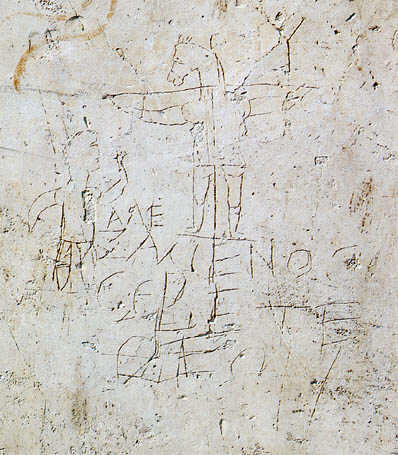
Roman graffitti dated 193-235 A.D. depicting a donkey-man being crucified
He was worshipped in mystery cults that offered a happy afterlife
Cicero indicates that the “polished and softened” mysteries of Iacchus (the third Dionysus) – mysteries which he himself was initiated in – and confirms that it provided hope in the afterlife. A ritual hymn at Delphi refers to Bacchus as Iacchos bringing salvation. Homer’s Hymn to Demeter confirms that the Eleusian mysteries promised a happy afterlife by the 500s B.C.
Marcus [Cicero]: But if we suppress the nocturnal sacrifices, what will become of the august mysteries of Iacchus, and the Eumolpidæ? For we are constructing laws, not for the Romans only, but for all just and valiant nations.
Atticus: I think it is but courteous to except these mysteries likewise, especially as we ourselves happen to have been initiated in them.
Marcus [Cicero]: With all my heart, let us except them. For it seems to me that among the many admirable and divine things your Athenians have established to the advantage of human society, there is nothing better than the mysteries by which we are polished and softened into politeness, from the rude austerities of barbarism. Justly indeed are they called initiations, for by them we especially learn the grand principles of philosophic life, and gain, not only the art of living agreeably, but of dying with a better hope.
Happy is he among men upon earth who has seen these mysteries; but he who is uninitiate and who has no part in them, never has lot of like good things once he is dead, down in the darkness and gloom.
With thy cup waving high,
With thy maddening revelry,
To Eleusis’ flowery vale
Comest thou—Bacchos, Paean, hail!
Thither thronging all the race
Come, of Hellas, seeking grace
Of thy nine-year revelation,
And they called thee by thy name,
Loved Iacchos, he who came
To bring salvation,
And disclose
His sure haven from all mortal woes.
His priest was led to the afterlife by a “good angel”
The tomb of a Sabazian priest, Vincentius, inside the Christian catacombs dated to 300s A.D., portrays a “good angel” (angelus bonus) leading him into a happy afterlife in the Elysian Fields. Another mural depicts a council of the gods, including Dispater (Hades) and Mercury.
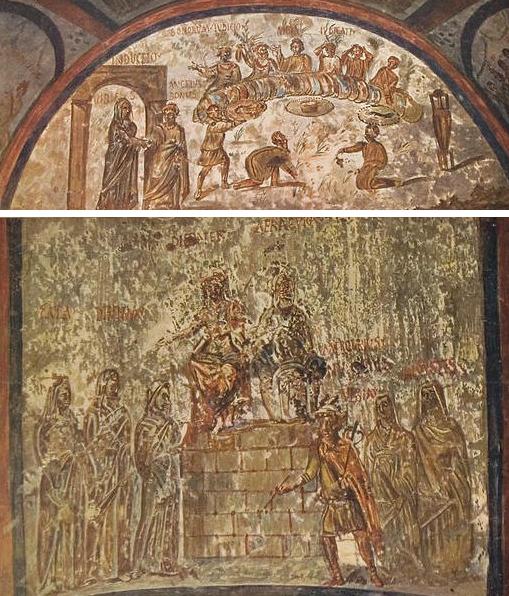
An angel leading a priest of Sabazios to an afterlife hosted by a council Greek gods

The council of gods hosting the dead, headed by Dispater (Hades)
He is featured on a tomb mosaic from a one-time secret Vatican necropolis containing a mixture of Christian and pagan symbols
In a Newsweek article titled “The Vatican's Pagan Cemetery”, Barbie Nadeau wrote that an ancient necropolis was found by accident in 2003 during construction for a new parking garage, but was only revealed to the public when local residents complained about mysterious dump trucks carrying tombstones and archaeological relics away. “Little further explanation was offered. But in the waning days of John Paul II's papacy, plans were made to open the graveyard to the public. John Paul himself was a student of Rome's pagan roots. But when he was succeeded by the more conservative Pope Benedict XVI, the plan was nearly derailed-until the Vatican's official archeologists insisted that the Holy See carry through the plans to honor the former pope.” Those buried in the necropolis are described as having both mixed social classes and religious beliefs. One tomb belonged to the set designer for Pompey’s Theatre, where Julius Caesar was killed, as well as mailmen and an archivist under the employ of Nero. Another sepulcher is decorated with angels and is believed by Vatican archaeologists to have belonged to a woman who was Christian. In another tomb, a pre-Christian symbol of resurrection, a hen’s egg left, is left beside the body of an infant. Another tomb of a 17-year-old Roman knight, portrays the picture of a woman with arms outstretched in prayer, a common depiction in early Christianity art known as “orant.” Gennaccari describes this as a potential belief in Christianity, saying, “It brings him into the Christian realm.” One Vatican museum archaeologist, Cristina Gennaccari, described the necropolis as belonging to people “on the verge of conversion to Christianity.” Close to one tomb carving that portrayed a man praying like a Christian is another tomb with a mosaic of Dionysus being held by a satyr.

Mosaic of Dionysus held up by a satyr in a vineyard found in Vatican necropolis
Next God: Orpheus
The Dying-and-Rising Gods
Leave Comments Here
|

